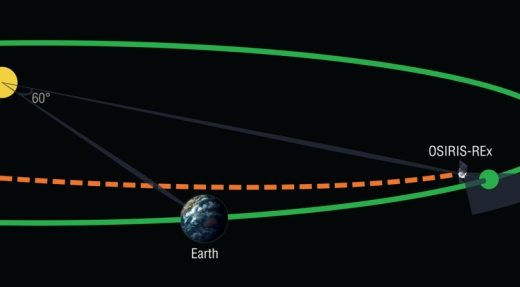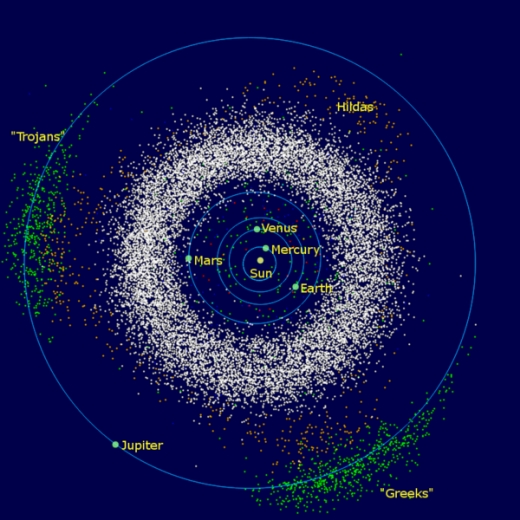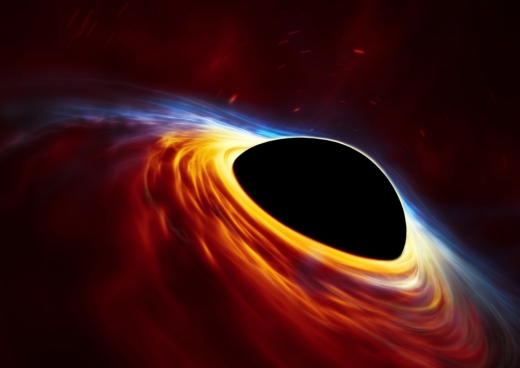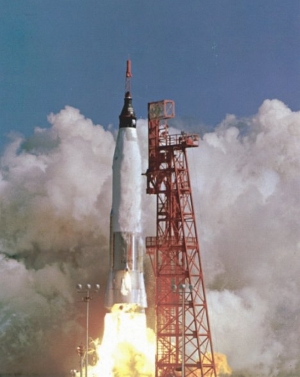by Paul Gilster | Dec 14, 2016 | Asteroid and Comet Deflection |
The so-called ‘trojan’ asteroids that cluster at 60° ahead and behind the planet Jupiter make up a surprisingly populous category. Consider that thus far we have found only one trojan at Earth’s Lagrangian points, while over 6000 have been discovered in Jupiter’s orbit. The total number of trojans larger than 1 km in diameter associated with Jupiter has been estimated to be about 1 million, which matches up well with objects of equivalent size in the main asteroid belt. These days ‘trojans’ can also refer to similar bodies associated with other planets. We know, for example, of about 20 trojans involved with Neptune.
That solitary Earth trojan, 2010 TK7, was discovered oscillating around Earth’s L4 Lagrangian point in 2010 by the NEOWISE team using NASA’s Wide-field Infrared Survey Explorer spacecraft. The object has a diameter of about 300 meters; its oscillations take it back and forth on a nearly 400 year cycle that at times puts it close to opposite the Sun with respect to the Earth. On the other side of its elongated loop of the L4 point, it can close to within about 20 million kilometers of Earth.
What catches the eye here is that 2010 TK7‘s orbit may have, within the past 2000 years, oscillated about the L5 Lagrangian point instead of L4. This seems to be an unstable libration, a fact that makes predicting its future course problematic. That’s why I’m interested in what scientists at the University of Arizona are doing with the OSIRIS-REx mission. Between February 9 and 20, the spacecraft’s onboard camera suite will be activated to search for other Earth trojans.

Image: In February 2017, the OSIRIS-REx spacecraft will undertake a search for Earth-Trojan asteroids while on its outbound journey to the asteroid Bennu. Earth trojans are asteroids that share an orbit with Earth while remaining near a stable point 60 degrees in front of or behind the planet. (Illustration: OSIRIS-REx/UA).
The problem with Earth’s trojans, assuming there is more than one, is that they are hard to find because from the Earth’s vantage point, they appear close to the Sun. OSIRIS-REx will deploy its MapCam imager to scan the regions where we might expect trojans to exist. The observations have a tactical purpose as well — consider them a warm-up for the encounter with the asteroid Bennu (1999 RQ36), the target of OSIRIS-REx. Checking for rocky material near Bennu will be critical as the spacecraft closes in for surface mapping in 2018. The mission will also attempt to return a sample of the asteroid to the Earth.
From a University of Arizona news release:
“The Earth-Trojan asteroid search provides a substantial advantage to the OSIRIS-REx mission,” said Dante Lauretta, OSIRIS-REx principal investigator and professor of planetary science at the Lunar and Planetary Laboratory. “Not only do we have the opportunity to discover new members of an asteroid class, but more importantly, we are practicing critical mission operations in advance of our arrival at Bennu, which ultimately reduces mission risk.”
So we may learn soon whether more Earth trojans exist, perhaps choosing one day to mine them for rare elements, although 2010 TK7 is not itself a good candidate for such operations (at least early on) because of its highly inclined orbit. Other near-Earth asteroids present better options.

Image: The inner Solar System, from the Sun to Jupiter. Also includes the asteroid belt (the white donut-shaped cloud), the Hildas (the orange “triangle” just inside the orbit of Jupiter), the Jupiter trojans (green), and the near-Earth asteroids. The group that leads Jupiter are called the “Greeks” and the trailing group are called the “Trojans” (Murray and Dermott, Solar System Dynamics, pg. 107). Credit: Wikimedia Commons.
And on the matter of nearby objects, you’ll recall 3753 Cruithne, a 5 kilometer wide asteroid whose orbit, an overlapping horseshoe, is not related to the kind of oscillations around the Lagrangian points associated with trojans. Another non-trojan near-Earth companion is (469219) 2016 HO3, considered by scientists to be a ‘quasi-satellite’ rather than a trojan. These asteroids are on curious and interesting orbits, and the suspicion is that we’ll find a good many more such objects in coming days.

by Paul Gilster | Dec 13, 2016 | Deep Sky Astronomy & Telescopes |
The supernova considered to be the brightest ever recorded may have been evidence of something even more exotic. The explosion was caught by the All Sky Automated Survey for SuperNovae (ASAS-SN), the event itself dubbed ASASSN-15h. Yesterday we looked at what happens to a star roughly as massive as the Sun as it goes through a red giant phase and becomes a white dwarf, but stars significantly more massive than the Sun take no such route. A star a minimum of 8 times the mass of the Sun can explode as a Type II supernova.
But is that what ASASSN-15h really was? Detected in 2015 in a galaxy about 4 billion light years from Earth, the event has now been the subject of new work by an international team led by Giorgos Leloudas (Weizmann Institute of Science, Israel) and the Dark Cosmology Centre (Denmark). From this we get a new explanation: ASASSN-15h may have been the result of a rapidly spinning supermassive black hole tearing a relatively low mass star apart. The passing star, in other words, lacked the mass to become a supernova, but the tidal disruption caused by the black hole led to its extreme outburst.

Image: An artist’s depiction of a rapidly spinning supermassive black hole surrounded the rotating leftovers of a star that was ripped apart by the tidal forces of the black hole.
Photo Credit: ESO, ESA/Hubble, M. Kornmesser.
A spectacular tidal event in the center of a galaxy sounds like something out of a Greg Benford novel, but in addition to the intrinsic fascination of ASASSN-15h comes a way to use it to delve into the physics of a black hole. For the mass of the host galaxy implies a black hole of at least 100 million solar masses, one that would be too large to disrupt stars outside its event horizon. As explained in the paper on this work, stars can only be disrupted outside the horizon of a supermassive black hole if the black hole is below a certain size — larger supermassive black holes, in other words, do disrupt stars, but by swallowing them whole.
We learn, though, that a spinning black hole — a so-called Kerr black hole, after Roy Kerr, the New Zealand mathematician who worked out the mathematics of such objects — would allow the disruption to occur, producing what had been thought to be a supernova. We wind up with a new tool for the exploration of extreme phenomena, as the paper explains:
… the typical tidally-disrupted star comes from the lower end of the stellar mass function, and this hypothesis [of a supernova] is further challenged by the old age of the galaxy’s stellar population. Observations of active galactic nuclei suggest that rapid SMBH [supermassive black hole] spins are common. We demonstrated here that TDEs [tidal disruption events] present a method to probe the SMBH spins of quiescent galaxies. Given the inferred rapid spin of the SMBH, the fact that we did not detect a jet at radio wavelengths implies that black hole spin alone is not sufficient to launch powerful jets.
The researchers agree that their evidence does not allow absolute certainty that ASASSN-15lh was a tidal disruption event. But there are sound reasons for thinking it so, including the location of the event in a red, massive galaxy of the kind not known to host superluminous supernova explosions, which usually occur in younger, star-forming dwarf galaxies. Moreover, their 10 months of observations from telescopes including the Hubble instrument, ESO’s Very Large Telescope and the the Las Cumbres Observatory Global Telescope showed three phases consistent with a tidal disruption event, including a re-brightening in ultraviolet light, that reduce the chances that this was a supernova.
“Even with all the collected data we cannot say with 100% certainty that the ASASSN-15lh event was a tidal disruption event,” adds Leloudas in this ESO news release. “But it is by far the most likely explanation.”
The paper is Leloudas et al., “The Superluminous Transient ASASSN-15lh as a Tidal Disruption Event from a Kerr Black Hole,” accepted by Nature Astronomy (preprint).

by Paul Gilster | Dec 12, 2016 | Deep Sky Astronomy & Telescopes |
The star L2 Puppis (HD 56096), a red giant in the direction of the southern constellation Puppis (the Poop Deck), is the subject of interesting new investigations using data from the ALMA array in Chile. The star appears to belong on the asymptotic giant branch of the Hertzsprung-Russell diagram, a category dominated by highly evolved cool stars. The new study sees L2 Puppis as an analog for what our own Sun will become in billions of years. Thus Ward Homan (KU Leuven Institute of Astronomy, Belgium):
“We discovered that L2 Puppis is about 10 billion years old. Five billion years ago, the star was an almost perfect twin of our Sun as it is today, with the same mass. One third of this mass was lost during the evolution of the star. The same will happen with our Sun in the very distant future.”

Image: Composite view of L2 Puppis in visible light | © P. Kervella et al. (CNRS/U. de Chile/Observatoire de Paris/LESIA/ESO/ALMA).
But L2 Puppis is more than just an interesting glimpse at what our Sun could become. It also offers a view of the fate of our own planet in the form of what may be an exoplanet discovered orbiting the star about 300 million kilometers out. Because as the Sun eventually moves into the red giant phase and grows more than a hundred times larger than it is today, Mercury and Venus will be destroyed, but the Earth may just hang on as a rocky core eventually orbiting a white dwarf. How the red giant phase affects planets in a system is what the L2 Puppis study is all about. Will a future Earth survive, and will it, as seems likely, be lifeless?
Asymptotic giant branch stars are undergoing a transition from red giants into the white dwarf remnants they will leave behind, meaning there is extreme loss of mass through a strong stellar wind. The resulting white dwarf at L2 Puppis should be about the size of the Earth, though compressed to the point where a single teaspoon weighs 5 tons. Stars like this also go through extreme changes in brightness and temperature, but studying the effects of these changes on their planetary systems is tricky because the planets are becoming embedded in a late-phase circumstellar envelope that can obscure observation.
At a distance of just over 200 light years, the circumstellar dust disk surrounding L2 Puppis is seen almost edge-on. The new work has allowed astronomers to arrive at a mass estimate for the star that, when adjusted through evolutionary models, shows it to have had a mass very similar to the Sun when it was on the main sequence. At 10 billion years old, the star also shows signs of a companion that, based upon its estimated mass is either a planet or a low-mass brown dwarf now accreting material from the star’s stellar wind.
It’s too early to call this a planet because the researchers have no firm lower limit on its mass, but this is an interesting object with an orbital period of about 5 years. From the paper:
From its observed properties, L2 Pup and its companion emerge as a plausible analog of the solar system at an age of approximately 10 Gyr. It provides a view on the complex interactions occurring between a solar-type star entering the planetary nebula phase and its planetary system. The companion could also play an important role in the shaping of the bipolar envelope of L2 Pup and subsequently of the planetary nebula…
So we’re learning more about the complex interactions involved when a star at this phase of its life undergoes the changes that will eventually lead to its becoming a white dwarf. Future observations both at ALMA and with the European Extremely Large Telescope (now under construction in Chile’s Atacama Desert) should offer a further window into these processes.
The paper is Kervella et al., “ALMA Observations of the nearby AGB star L2 Puppis,” published online by Astronomy & Astrophysics 8 December 2016 (abstract / preprint).

by Paul Gilster | Dec 9, 2016 | Uncategorized |
John Glenn was 95 when he died, but I have to admit I didn’t think he’d make it to 41. The first American to orbit the Earth was 40 years old when he rode an Atlas rocket into the sky on February 20, 1962. I was a gawky kid, space-crazed, who had read absolutely everything I could find about the space program, and I knew just enough to understand that the Atlas, for all its muscular beauty, wasn’t necessarily the safest thing you’d want to fly.

Our school had set up a black and white television on the stage in the auditorium so we could all see the liftoff, which took place at 8:47 A.M. in St. Louis. In this era of enormous home viewing screens it’s hard to imagine what a single small television could show to an auditorium filled with students, but at the time it was a window into history and we watched avidly as the rocket cut into the sky, and got later updates from teachers as Glenn orbited.
We all assumed the hard part was over after the launch, and I know I was certainly breathing easier, but of course we’ve come to learn that there were concerns about the Friendship 7’s heat shield because of what would turn out to be a faulty indicator. Controllers instructed Glenn to leave the retro-rocket pack on over the shield to help keep it in place, leading to metal straps breaking free during re-entry and banging against the side of the capsule. After splashing down, he would radio: “My condition is good, but that was a real fireball, boy.”
Nor was the heat shield concern Glenn’s only problem. A yaw attitude jet became clogged in his first orbit, forcing the astronaut to take manual control of the capsule. But this was a flier whose instincts were well honed. Flying Corsairs for Marine squadron VMF-155, he would see 59 combat missions in the Pacific, numerous training missions in the years after, and then further duty flying jets in Korea, where he racked up another 90 combat missions. At one point his wingman was baseball legend Ted Williams. In 1957, he would complete the first supersonic transcontinental flight, a feat he managed in 3 hours and 23 minutes.
Glenn’s decision to go into politics may well have originated out of frustration at not being able to get another space mission as the Gemini and Apollo programs advanced, although he also worked for a time as a business executive before making it to the U.S. Senate. He was in an awkward position, with his status as a national hero keeping him out of the active flight roster, although as Centauri Dreams readers know, he would return to space in 1998 aboard the shuttle Discovery, a visit that would make him the oldest person to fly in space.
This New York Times essay by John Noble Wilford captures the character of the man, an iconic figure with a gift for understatement and a hugely likable humility:
Mr. Glenn was reluctant to talk about himself as a hero. “I figure I’m the same person who grew up in New Concord, Ohio, and went off through the years to participate in a lot of events of importance,” he said in an interview years later. “What got a lot of attention, I think, was the tenuous times we thought we were living in back in the Cold War. I don’t think it was about me. All this would have happened to anyone who happened to be selected for that flight.”
We also learn that Glenn was so determined to get into the new astronaut program in 1959 that he put weights on his head, trying to compress himself down to the 5-foot-11-inch maximum required. Like, I suppose, all of the original Mercury 7, Glenn wanted to be aboard the first American flight into space, but these days it’s not Alan Shepard’s suborbital Redstone flight but Glenn’s three orbits that most symbolize the drama of the early program.

And how about this from Wilford’s essay, on the 1983 film The Right Stuff?
Mr. Glenn said he liked the book but not the 1983 movie based on it, in which he was portrayed by Ed Harris. “Most of his account was reasonably factual, although I was neither the pious saint nor the other guys the hellions he made them into,” he told Life magazine in 1998. “Hollywood made a charade out of the story and caricatures out of the people in it.”
I spent the evening recalling that liftoff from Pad 14. Sadness was part of the equation, but I also felt a certain lightness of being. Here was a man who lived well and long, fully 95 years, a man who flew his Beechcraft Baron until he was 90, a man who lived with the woman he loved for 73 years. Who could hope to do better than that? For me, this doggedly courageous man will always be arcing up into a bright February sky. He calls up these lines of Leonardo da Vinci: “Knowing is not enough; we must apply. Being willing is not enough; we must do.”

by Paul Gilster | Dec 8, 2016 | Exoplanetary Science |
The Australian Institute of Physics Congress ends today in Brisbane, concluding a schedule of talks that can be viewed here. Among the numerous research presentations was the description of a new optical chip for telescopes that should help astronomers tease out the image of a planet through thermal imaging, nulling out the light of the host star. The new photonic chip could be a replacement for bulk optics at the needed mid-infrared wavelengths.
Harry-Dean Kenchington Goldsmith, a PhD candidate who built the chip at the Australian National University Physics Center, says that the same technology that allows astronomers to penetrate dust clouds to see planets in formation will also be used to study the atmospheres of potentially life-bearing planets. ANU’s Steve Madden describes the chip as an interferometer that “adds equal but opposite light waves from a host sun which cancels out the light from the sun,” making it possible to detect the much fainter light of a planet. He likened the chip’s operation to the methods used in noise cancelling headphones.
This is important work because to understand planet formation, we have to learn more about how planets emerge from the gaseous disk surrounding the parent star. Doing this requires direct imaging at mid-infrared wavelengths, a method that has yielded young planets in formation as well as large exoplanets in distant orbits from their hosts. The next step will be to improve our methods of blanking out the star’s light for better imaging and, as this ANU news release points out, spectroscopic analysis of planetary atmospheres.

Image: The telescope chip developed at Australian National University. Credit: Stuart Hay/ANU.
It turns out that Ronald Bracewell (yes, that Bracewell) discussed these issues back in 1978, proposing what has come to be called the Bracewell nuller, which causes light from a star to destructively interfere, cancelling the star’s light so the planet can be observed. Thinking ahead to our own era of exoplanet discovery, Bracewell suggested using the method as a way to find planets around other stars. Along with a coronagraph (a different technique altogether), a nulling interferometer was considered for use in two high visibility but ultimately cancelled missions, NASA’s Terrestrial Planet Finder and the European Space Agency’s Darwin.
The ANU team brings nulling techniques to a photonic chip. This morning while digging around in the paper on this work, I received a comment from Centauri Dreams reader Mike Fidler, who pointed readers to a shorter (though highly technical) description of the chip in one of ANU’s publications. The key point here is that using photonic chips we can replace some operations normally handled through conventional optics. From the paper on this work:
Photonic integrated circuits are established as the technique of choice for a number of astronomical processing functions due to their compactness, high level of integration, low losses, and stability. Temperature control, mechanical vibration and acoustic noise become controllable for such a device enabling much more complex processing than can realistically be considered with bulk optics.
These are major benefits, making this a technology we’ll continue to follow with interest.
Ronald Bracewell’s original paper on nulling concepts was “Detecting nonsolar planets by spinning infrared interferometer,” Nature 274 (24 August 1978), 780-781 (abstract). For Goldsmith and Madden’s work, see Goldsmith et al., “Chalcogenide glass planar MIR couplers for future chip based Bracewell interferometers,” in Proc. SPIE 9907, Optical and Infrared Interferometry and Imaging V, 990730 (August 4, 2016) (preprint).










